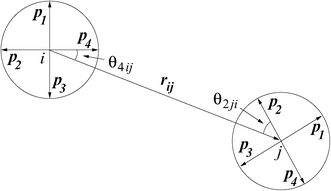Patchy particles: Difference between revisions
Jump to navigation
Jump to search
m (Removed stub template) |
Carl McBride (talk | contribs) m (Added more structure to page) |
||
| Line 1: | Line 1: | ||
The general model for a '''patchy particle''' is given by | The general model for a '''patchy particle''' <ref>[http://dx.doi.org/10.1021/nl0493500 Zhenli Zhang and Sharon C. Glotzer "Self-Assembly of Patchy Particles", Nano Letters '''4''' pp. 1407-1413 (2004)]</ref> is given by | ||
<ref>[http://dx.doi.org/10.1039/b614955c Jonathan P. K. Doye, Ard A. Louis, I-Chun Lin, Lucy R. Allen, Eva G. Noya, Alex W. Wilber, Hoong Chwan Kok and Rosie Lyus "Controlling crystallization and its absence: proteins, colloids and patchy models", Physical Chemistry Chemical Physics '''9''' pp. 2197-2205 (2007)]</ref> | <ref>[http://dx.doi.org/10.1039/b614955c Jonathan P. K. Doye, Ard A. Louis, I-Chun Lin, Lucy R. Allen, Eva G. Noya, Alex W. Wilber, Hoong Chwan Kok and Rosie Lyus "Controlling crystallization and its absence: proteins, colloids and patchy models", Physical Chemistry Chemical Physics '''9''' pp. 2197-2205 (2007)]</ref> | ||
| Line 15: | Line 15: | ||
where <math>u_{\mathrm {LJ}}(r_{ij})</math> is the [[Lennard-Jones model | Lennard-Jones potential]] and | where <math>u_{\mathrm {LJ}}(r_{ij})</math> is the [[Lennard-Jones model | Lennard-Jones potential]] and | ||
[[Image:patchy_model.png|center]] | [[Image:patchy_model.png|center]] | ||
==Anisotropy dimensions== | |||
Anisotropy dimensions is a classification scheme for patchy particles (See Figure 2 of <ref>[http://dx.doi.org/10.1038/nmat1949 Sharon C. Glotzer and Michael J. Solomon "Anisotropy of building blocks and their assembly into complex structures", Nature Materials '''6''' pp. 557-562 (2007)]</ref>). | |||
The eight attributes are as follows: | |||
====Surface coverage (A)==== | |||
====Aspect ratio (B)==== | |||
====Faceting (C)==== | |||
====Pattern quantisation (D)==== | |||
====Branching (E)==== | |||
====Chemical ordering (F)==== | |||
====Shape gradient (G)==== | |||
====Roughness (H)==== | |||
==See also== | ==See also== | ||
*[[Colloids]] | |||
*[[Emulsions]] | |||
*[[Janus particles]] | |||
*[[Phase diagram of anisotropic particles with octahedral symmetry]] | *[[Phase diagram of anisotropic particles with octahedral symmetry]] | ||
*[[Phase diagram of anisotropic particles with tetrahedral symmetry]] | *[[Phase diagram of anisotropic particles with tetrahedral symmetry]] | ||
*[[Wertheim's first order thermodynamic perturbation theory (TPT1)]] | |||
==References== | ==References== | ||
<references/> | <references/> | ||
'''Related reading''' | |||
*[http://dx.doi.org/10.1002/marc.200900614 Amar B. Pawar and Ilona Kretzschmar "Fabrication, Assembly, and Application of Patchy Particles", Macromolecular Rapid Communications '''31''' pp. 150-168 (2010)] | |||
[[category: models]] | [[category: models]] | ||
Revision as of 14:16, 22 February 2010
The general model for a patchy particle [1] is given by [2]
where is the Lennard-Jones potential and

Anisotropy dimensions
Anisotropy dimensions is a classification scheme for patchy particles (See Figure 2 of [3]). The eight attributes are as follows:
Surface coverage (A)
Aspect ratio (B)
Faceting (C)
Pattern quantisation (D)
Branching (E)
Chemical ordering (F)
Shape gradient (G)
Roughness (H)
See also
- Colloids
- Emulsions
- Janus particles
- Phase diagram of anisotropic particles with octahedral symmetry
- Phase diagram of anisotropic particles with tetrahedral symmetry
- Wertheim's first order thermodynamic perturbation theory (TPT1)
References
- ↑ Zhenli Zhang and Sharon C. Glotzer "Self-Assembly of Patchy Particles", Nano Letters 4 pp. 1407-1413 (2004)
- ↑ Jonathan P. K. Doye, Ard A. Louis, I-Chun Lin, Lucy R. Allen, Eva G. Noya, Alex W. Wilber, Hoong Chwan Kok and Rosie Lyus "Controlling crystallization and its absence: proteins, colloids and patchy models", Physical Chemistry Chemical Physics 9 pp. 2197-2205 (2007)
- ↑ Sharon C. Glotzer and Michael J. Solomon "Anisotropy of building blocks and their assembly into complex structures", Nature Materials 6 pp. 557-562 (2007)
Related reading

